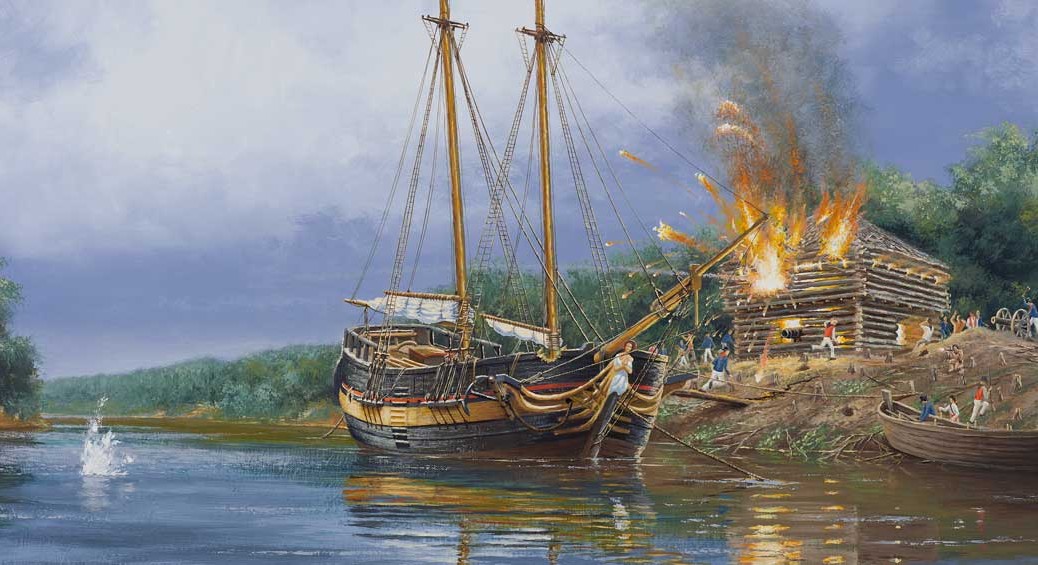On 23 July 1949, a human skeleton was unearthed from the bank of the Nottawasaga River in Wasaga Beach by two young women vacationing in the area. The adult male skeleton was recovered with nothing more than a single military button determined as being of Scottish origin dating as far back as the War of 1812. Dr. RE Ives of Stayner examined the skeleton and was of the opinion that the bones were over 100 years old. The remains were found in close proximity to where the HMS Nancy, a British supply schooner, was destroyed after a battle with American forces on August 14th, 1814.
One month after the discovery, the Stayner Branch of the Canadian Legion decided to re-inter the remains with full military honours as a veteran of the War of 1812. On August 28th, 1949, the ceremony took place where Capt. Rev. E Ralph Adye, L. Th., a veteran of the two World Wars and Rector of All Saints’ Anglican Church gave the address. A few excerpts from Rev. Adye’s speech are included below:
“Today we have paid respect to a soldier of the Empire by honorably re-interring his bones which were so unexpectedly disclosed in their first resting place in the sandy banks of the Nottawasaga River last month” … “It is fortunate that we live in a civilization with believes in and practices, the proper and honourable burial of its dead. John Ingalls had said: ‘In all the democracy of the dead all men are at last equal. There is neither rank nor station nor prerogative in republic of the grave.’ Noble or commoner, rich or poor, famous or humble, the dead of our land are laid away with dignity and reverence. This solemn duty to care for our dead takes on special significance of this occasion.”
Rev. Adye’s address and portions of the reburial ceremony was broadcast over CFOS in Owen Sound for the CBC International Service. As the flag-draped coffin was lowered into the grave the famous Scottish lament, Flowers of the Forest was played by the Collingwood Pipe Band and the Last Post was sounded by Bugler Mac Jones.
Today, the remains of this individual are buried in a permanent gravesite on Nancy Island Historic Site where over 10,000 visitors per year pay their respects to those who have fought, and died in war. At present, we do not have birth date, death date, or even a name for this soldier and because his identity remains unknown, he is referred to as the Unknown Soldier. The headstone of the Unknown Soldier located at Nancy Island reads:
Here lies a British solder of the War of 1812-1814
His remains were uncovered July 23, 1949
on the bank of the Nottawasaga River
two miles from the river mouth
He was buried with full military honours at
this location on Nancy Island Sept 6, 1949Known only unto God
Dedicated to Service Veterans
Past-Present-Future
Importantly, this Unknown Soldier not only represents his personal sacrifices as a soldier in the War of 1812, but he represents all the unknown and unfound dead of the War. Those soldiers who fought and died, but cannot be identified, deserve the same respect and honour as identified soldiers. His status as ‘unknown’ pays tribute to those lost at sea, buried in unmarked graves, and those lost on the battlefield. Red Geraniums are planted annually in front of the headstone to commemorate the sacrifices made by both the known and unknown soldiers who bravely and proudly fought for their country in the War of 1812.
[Graveside Team ed — The painting HMS Nancy Last Stand is courtesy of Peter Rindlisbacher. A well known and professional naval painter. It depicts the point at which the ill-fated Nancy is trapped on the Nottawasaga River, trying to evade notice of the American ships and is subsequently scuttled to prevent falling into the enemies hands.]

